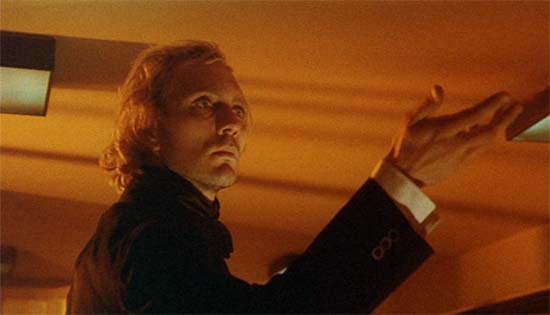 Three tales of the decadent and the damned…
Three tales of the decadent and the damned…
Spirits of the Dead – aka Histoires Extraordinaires, aka Tre Passi Nel Delirio, aka Tales of Mystery and Imagination – is a portmanteau film, popular in Europe in the 1960’s as a means of bringing together the biggest names in international cinema on a single bill. Films such as Boccaccio ’70 (1962), Ro.Go.Pa.G. (1963), The Beautiful Swindlers (1964), and The Witches (1967), were just as much about their world-class directors as star-studded casts, and the auteurs, given the excuse to make a short film, were often eager to indulge their experimental sides. Despite occasional attempts to revive the form (1989’s New York Stories, 1995’s Four Rooms, 2006’s Paris, Je T’Aime), it seems to be a fashion principally of its era. Of the many anthology films released during this period, however, I have the greatest affection for Spirits of the Dead. Partly because it’s so haunting…and partly because it’s so very, very strange.
The premise is intriguing: in answer to the Roger Corman/Vincent Price adaptations of Edgar Allan Poe stories flowing nonstop out of America, three European directors would offer their take on Poe, choosing less familiar tales and applying their own visual poetry. The directors chosen were Federico Fellini, Louis Malle, and Roger Vadim. If it seems that one of these is not like the others, that’s because over the ensuing decades, Vadim’s star has fallen somewhat, whereas Fellini and Malle have only grown in stature. Consider that Vadim had, behind him, the breakthrough …And God Created Woman (1956), as well as Les Liaisons Dangereuses (1959). Having introduced the world to Brigitte Bardot, he was as responsible for sexing up the French brand for international audiences as Serge Gainsbourg and Jules and Jim. But right after Spirits of the Dead he would make arguably his most famous, and notorious, film, Barbarella, and his style would turn irretrievably to camp. His name would remain synonymous with the swinging 60’s, but his films just as swiftly dated.
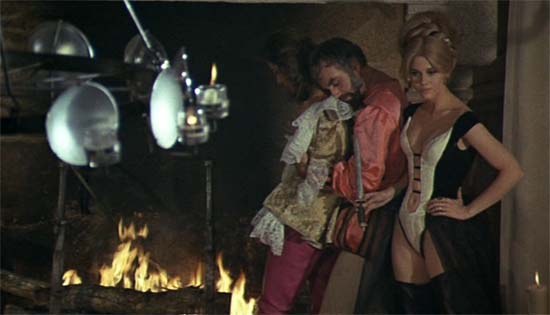 His short here features Barbarella‘s star, and Vadim’s current squeeze, Jane Fonda. In “Metzengerstein,” Fonda is the corrupt Hungarian countess Frederique Metzengerstein (flipping the gender of Baron Frederick in Poe’s original), indulging in orgies at her estate, playing with her pet baby leopard, and, for kicks, cruelly tormenting her vassals. The fashion-conscious Vadim ensures that in each scene, no matter how brief, Fonda is wearing a new, eye-popping, absurd ensemble, most of which share the science fiction comic-strip look of her famous wardrobe in Barbarella. When Frederique meets her cousin, Wilhelm (Peter Fonda), of the rival family Berlifitzing, she becomes obsessed by his beauty and apparent moral purity. Much has been made of the ick factor in Jane Fonda pursuing her brother, but their short moments together are chaste and completely devoid of sensuality. In one moment, the Baron Wilhelm sits at a window in a crumbling castle, feeding an owl, and gazing serenely down at Frederique. It’s not erotic; it’s Harry Potter.
His short here features Barbarella‘s star, and Vadim’s current squeeze, Jane Fonda. In “Metzengerstein,” Fonda is the corrupt Hungarian countess Frederique Metzengerstein (flipping the gender of Baron Frederick in Poe’s original), indulging in orgies at her estate, playing with her pet baby leopard, and, for kicks, cruelly tormenting her vassals. The fashion-conscious Vadim ensures that in each scene, no matter how brief, Fonda is wearing a new, eye-popping, absurd ensemble, most of which share the science fiction comic-strip look of her famous wardrobe in Barbarella. When Frederique meets her cousin, Wilhelm (Peter Fonda), of the rival family Berlifitzing, she becomes obsessed by his beauty and apparent moral purity. Much has been made of the ick factor in Jane Fonda pursuing her brother, but their short moments together are chaste and completely devoid of sensuality. In one moment, the Baron Wilhelm sits at a window in a crumbling castle, feeding an owl, and gazing serenely down at Frederique. It’s not erotic; it’s Harry Potter.
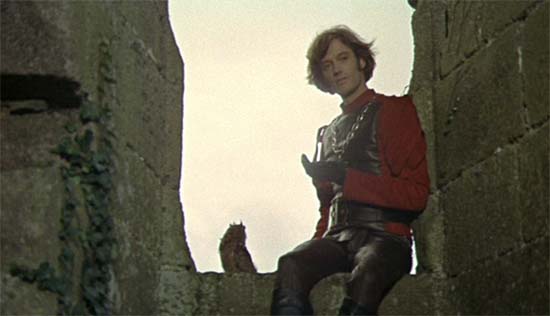 Of course, it’s also impeccably composed. Vadim winds his way toward the plot gradually, relying equally upon voice-over narration and long, dialogue-free scenes of musical montage, setting a mood with gorgeous cinematography by Claude Renoir. The camera drifts over the action, passing in and out of focus, composing its visual narrative almost impressionistically as we get around to crucial details: Frederique arranges a calamitous fire at the Berlifitzing stables, and Baron Wilhelm is accidentally killed in the conflagration; at that moment, a black horse arrives mysteriously at the Metzengerstein estate, and the image of an identical black horse is somehow burned out of an ancient tapestry she adores. Obsessed with the idea that the horse might be the reincarnation of Wilhelm, Frederique spends every waking hour grooming the creature, riding it through the countryside, even singing it songs (and, in an unintentionally funny moment, whispering secrets into its nostrils). She commands that the tapestry be repaired, and as that work nears its completion, a lightning storm brings wildfires to the countryside; Frederique, upon her horse, rides out, obsessively pursuing her fate. Like most Poe protagonists, she seems to yearn for death.
Of course, it’s also impeccably composed. Vadim winds his way toward the plot gradually, relying equally upon voice-over narration and long, dialogue-free scenes of musical montage, setting a mood with gorgeous cinematography by Claude Renoir. The camera drifts over the action, passing in and out of focus, composing its visual narrative almost impressionistically as we get around to crucial details: Frederique arranges a calamitous fire at the Berlifitzing stables, and Baron Wilhelm is accidentally killed in the conflagration; at that moment, a black horse arrives mysteriously at the Metzengerstein estate, and the image of an identical black horse is somehow burned out of an ancient tapestry she adores. Obsessed with the idea that the horse might be the reincarnation of Wilhelm, Frederique spends every waking hour grooming the creature, riding it through the countryside, even singing it songs (and, in an unintentionally funny moment, whispering secrets into its nostrils). She commands that the tapestry be repaired, and as that work nears its completion, a lightning storm brings wildfires to the countryside; Frederique, upon her horse, rides out, obsessively pursuing her fate. Like most Poe protagonists, she seems to yearn for death.
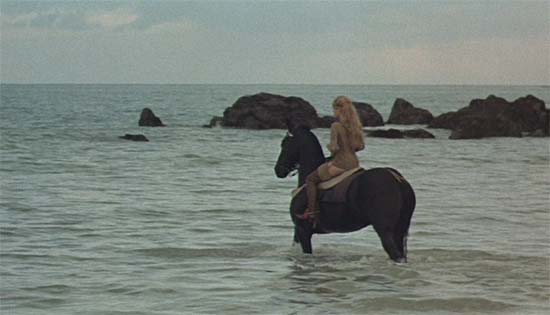 “Metzengerstein” is often considered the nadir of Spirits of the Dead, and it’s certainly the weakest segment, stumbling as it attempts to stride that fine line between art-house fantasy and camp…but it all looks so damn lovely that it’s easy to forgive its shortcomings. Most importantly, however, it establishes a certain fever-dream logic, decadence, and visual splendor that will unite all three of the shorts. In that regard, it performs its duties quite well. It’s an experiment in mood whose indulgences might not have aged well, but aren’t without their charms.
“Metzengerstein” is often considered the nadir of Spirits of the Dead, and it’s certainly the weakest segment, stumbling as it attempts to stride that fine line between art-house fantasy and camp…but it all looks so damn lovely that it’s easy to forgive its shortcomings. Most importantly, however, it establishes a certain fever-dream logic, decadence, and visual splendor that will unite all three of the shorts. In that regard, it performs its duties quite well. It’s an experiment in mood whose indulgences might not have aged well, but aren’t without their charms.
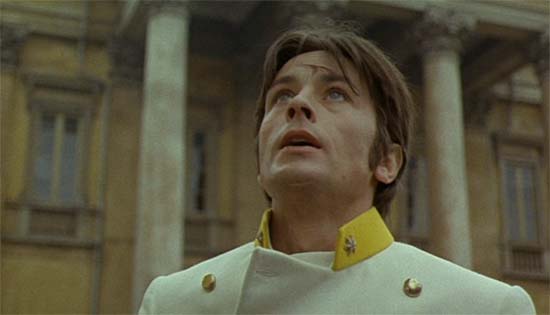 Yes, “William Wilson” is a big step up, but Louis Malle is a more interesting and versatile talent; this short is typical of his style, grounding envelope-pushing material with observant and devastating psychology. Art-house idol Alain Delon plays a dual role as William Wilson, a young man who never misses a chance to exercise his sadistic tendencies as he rises through the social classes; and William Wilson, a mysterious doppelgänger keeping a close eye on him. The framing device is a confessional, as the desperate Wilson #1 intends to confess just one sin, but lays out, unapologetically, a lifetime of crimes to the shocked priest. As a child Wilson strings up a classmate to lower him teasingly into a box of rats, until Wilson #2 arrives. As a med student, he abducts a young woman, binds her naked to an operating table to the delight of his amoral friends, and is about to – rape her? draw blood with his scalpel? – before Wilson #2 intervenes. Finally, he engages in a duel with a beautiful socialite (Brigitte Bardot) as an all-night game of poker. At first, she has the upper hand, and uses every win to further emasculate him verbally. But Wilson’s luck turns, and as dawn breaks, he offers her an all-or-nothing wager, with her body on the betting table. She loses, and he whips her savagely. He’s about to sexually humiliate her as well, before Wilson #2 once more appears, masked like a bandit. He proves to everyone that Wilson #1 was cheating, and immediately gets him disbarred from the club. Subsequently, Wilson #1 murders his double.
Yes, “William Wilson” is a big step up, but Louis Malle is a more interesting and versatile talent; this short is typical of his style, grounding envelope-pushing material with observant and devastating psychology. Art-house idol Alain Delon plays a dual role as William Wilson, a young man who never misses a chance to exercise his sadistic tendencies as he rises through the social classes; and William Wilson, a mysterious doppelgänger keeping a close eye on him. The framing device is a confessional, as the desperate Wilson #1 intends to confess just one sin, but lays out, unapologetically, a lifetime of crimes to the shocked priest. As a child Wilson strings up a classmate to lower him teasingly into a box of rats, until Wilson #2 arrives. As a med student, he abducts a young woman, binds her naked to an operating table to the delight of his amoral friends, and is about to – rape her? draw blood with his scalpel? – before Wilson #2 intervenes. Finally, he engages in a duel with a beautiful socialite (Brigitte Bardot) as an all-night game of poker. At first, she has the upper hand, and uses every win to further emasculate him verbally. But Wilson’s luck turns, and as dawn breaks, he offers her an all-or-nothing wager, with her body on the betting table. She loses, and he whips her savagely. He’s about to sexually humiliate her as well, before Wilson #2 once more appears, masked like a bandit. He proves to everyone that Wilson #1 was cheating, and immediately gets him disbarred from the club. Subsequently, Wilson #1 murders his double.
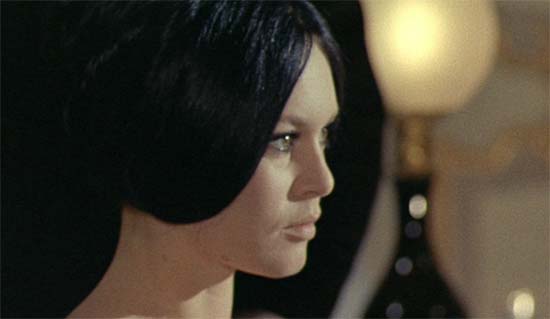 As the doppelgänger is dying, he explains that William Wilson needs him; that in his absence, Wilson will now cease to exist. In existential fright, perhaps, Wilson flees to the church – but cannot obtain the absolution he desires from the priest (who optimistically recommends changing his ways and finding a loyal wife). He sprints to the top of a belltower and hurls himself off it, a moment visually presaged at the beginning of the story. An underrated achievement, Malle’s film conjures the woozy dread of a Poe tale while coldly and clinically dissecting the evil in William Wilson’s heart. The viewer calls into question the veracity of Wilson’s shadow from the very beginning, but while Malle lets the fantastique elements care for themselves (can a man endure if he loses his soul?), he seems more interested in creating a character portrait of a man who can’t recognize his own wickedness.
As the doppelgänger is dying, he explains that William Wilson needs him; that in his absence, Wilson will now cease to exist. In existential fright, perhaps, Wilson flees to the church – but cannot obtain the absolution he desires from the priest (who optimistically recommends changing his ways and finding a loyal wife). He sprints to the top of a belltower and hurls himself off it, a moment visually presaged at the beginning of the story. An underrated achievement, Malle’s film conjures the woozy dread of a Poe tale while coldly and clinically dissecting the evil in William Wilson’s heart. The viewer calls into question the veracity of Wilson’s shadow from the very beginning, but while Malle lets the fantastique elements care for themselves (can a man endure if he loses his soul?), he seems more interested in creating a character portrait of a man who can’t recognize his own wickedness.
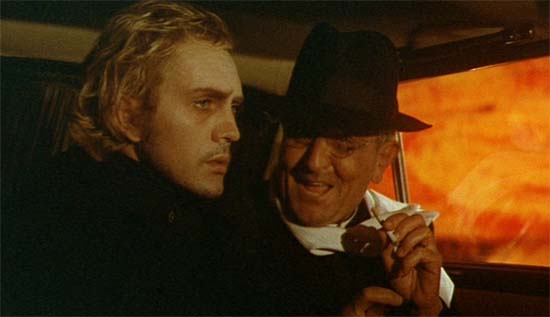 But when Spirits of the Dead is discussed among film buffs, it’s Federico Fellini’s “Toby Dammit” which garners all the enthusiasm, and justifiably so. Fellini liberally adapts Poe’s “Never Bet the Devil Your Head” into, well, a Fellini movie, and all that entails. It’s a kaleidoscopic journey through a contemporary Dante’s Inferno, as seen from the perspective of a British film star, Toby Dammit (Terence Stamp), arriving in Rome to shoot his latest picture, a Western take on the story of Jesus Christ. Taking swigs from a flask while blanched to a skull-like pallor and drenched in sweat, Toby could be Poe himself, transported to late-60’s Cinecittà Studios, surrounded by sycophants, paparazzi, movie producers and hangers-on, observing all of them in confusion, horror, and humor, by turns.
But when Spirits of the Dead is discussed among film buffs, it’s Federico Fellini’s “Toby Dammit” which garners all the enthusiasm, and justifiably so. Fellini liberally adapts Poe’s “Never Bet the Devil Your Head” into, well, a Fellini movie, and all that entails. It’s a kaleidoscopic journey through a contemporary Dante’s Inferno, as seen from the perspective of a British film star, Toby Dammit (Terence Stamp), arriving in Rome to shoot his latest picture, a Western take on the story of Jesus Christ. Taking swigs from a flask while blanched to a skull-like pallor and drenched in sweat, Toby could be Poe himself, transported to late-60’s Cinecittà Studios, surrounded by sycophants, paparazzi, movie producers and hangers-on, observing all of them in confusion, horror, and humor, by turns.
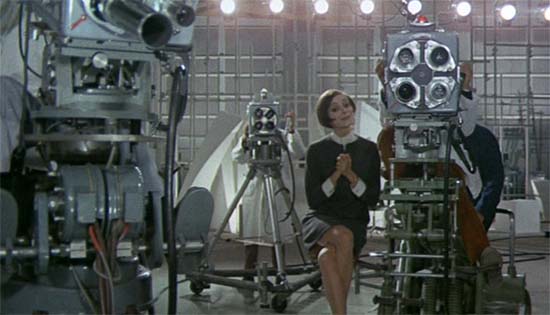 He arrives in an airport populated by surreal tableaus, some of which are two-dimensional, black-and-white cutouts standing in for crowds. The sky is blood-red, and he slinks away from any contact, fleeing, like a vampire, at the flashes of the cameras and any bright lights. After passing through deliberately artificial streetscapes, he arrives at a television studio where he’s met by a madly grinning host seated upon a stool joined to a camera that dollies forward and back again, so that she swoops about in front of him like a bird, conducting an interview that plays like a twisted take on a 1964 Beatles press conference. (“Was your childhood unhappy?” “No,” he responds, “my mother always laughed when she hit me.”) His one goal is to make it through the evening – sit through an awards ceremony, endure the lights and the vultures – on the promise that he’ll be rewarded with a shiny new Ferrari. But he’s haunted by the specter of a blonde-haired girl playing with a white ball. A memory from his childhood? A longing for the simple pleasures of his youth? But the Devil, he insists, will be a little girl.
He arrives in an airport populated by surreal tableaus, some of which are two-dimensional, black-and-white cutouts standing in for crowds. The sky is blood-red, and he slinks away from any contact, fleeing, like a vampire, at the flashes of the cameras and any bright lights. After passing through deliberately artificial streetscapes, he arrives at a television studio where he’s met by a madly grinning host seated upon a stool joined to a camera that dollies forward and back again, so that she swoops about in front of him like a bird, conducting an interview that plays like a twisted take on a 1964 Beatles press conference. (“Was your childhood unhappy?” “No,” he responds, “my mother always laughed when she hit me.”) His one goal is to make it through the evening – sit through an awards ceremony, endure the lights and the vultures – on the promise that he’ll be rewarded with a shiny new Ferrari. But he’s haunted by the specter of a blonde-haired girl playing with a white ball. A memory from his childhood? A longing for the simple pleasures of his youth? But the Devil, he insists, will be a little girl.
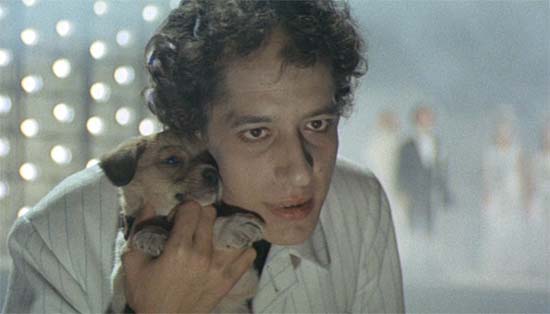 The awards show itself gives Fellini the opportunity to push into full 8 1/2 mode, reflecting all the usual showbiz archetypes in a warped mirror, ghoulishly transforming them. A creepy, Peter Lorre-like magazine photographer states that Toby Dammit has been enlisted for a shoot which will portray him as the god Mars, completely nude. A fashion parade onstage offers new styles with names like “Humiliation.” A typical show business mother introduces her sixteen-year-old daughter to Toby, as though offering her to him as a sacrifice. “Is she a virgin?” Toby asks mockingly, before escaping, giggling, back into his shell. The awards recipients give identical acceptance speeches, carefully practiced humility. Toby winces and squirms, he pulls grotesque faces when he’s asked a question. No one seems to notice; or they laugh, oblivious to the joke.
The awards show itself gives Fellini the opportunity to push into full 8 1/2 mode, reflecting all the usual showbiz archetypes in a warped mirror, ghoulishly transforming them. A creepy, Peter Lorre-like magazine photographer states that Toby Dammit has been enlisted for a shoot which will portray him as the god Mars, completely nude. A fashion parade onstage offers new styles with names like “Humiliation.” A typical show business mother introduces her sixteen-year-old daughter to Toby, as though offering her to him as a sacrifice. “Is she a virgin?” Toby asks mockingly, before escaping, giggling, back into his shell. The awards recipients give identical acceptance speeches, carefully practiced humility. Toby winces and squirms, he pulls grotesque faces when he’s asked a question. No one seems to notice; or they laugh, oblivious to the joke.
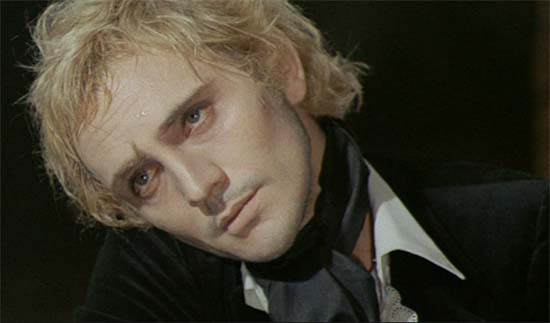 As he hides in the darkness, shadows cloaking his face, one mysterious woman says she understands him. She takes his hand tenderly. A Ray Charles song plays. He looks up at her, and she’s granted a close-up: an austere beauty, in black eyeliner and false eyelashes. Her penetrating eyes seem too large, like a surreal caricature, but Toby seems momentarily moved or affected. It doesn’t last. Accepting his award, he condemns her from the stage, and objects to the notion that anyone would honor him: he’s an alcoholic; he hasn’t worked in a year; he says he’s a fraud. After this meltdown, he runs to his waiting Ferrari. For once, Toby displays glimmers of genuine happiness: alone at last, sensually caressing the wheel of his new sportscar.
As he hides in the darkness, shadows cloaking his face, one mysterious woman says she understands him. She takes his hand tenderly. A Ray Charles song plays. He looks up at her, and she’s granted a close-up: an austere beauty, in black eyeliner and false eyelashes. Her penetrating eyes seem too large, like a surreal caricature, but Toby seems momentarily moved or affected. It doesn’t last. Accepting his award, he condemns her from the stage, and objects to the notion that anyone would honor him: he’s an alcoholic; he hasn’t worked in a year; he says he’s a fraud. After this meltdown, he runs to his waiting Ferrari. For once, Toby displays glimmers of genuine happiness: alone at last, sensually caressing the wheel of his new sportscar.
But even speeding through the streets of Rome at night, he can’t escape. Increasingly, it all seems like a movie set. More of the cardboard cutouts begin to appear, standing in for real items or people, as well as mannequins and stuffed animals. It’s like the reality collapse in a Philip K. Dick novel (see: Time Out of Joint or Ubik). Flooring the pedal, screeching through the empty streets, knocking over the dummies, he can only swoop in a circle, until at last he discovers a bridge to freedom. And the bridge is out. On the other side, he glimpses a little blonde girl playing with a white ball…
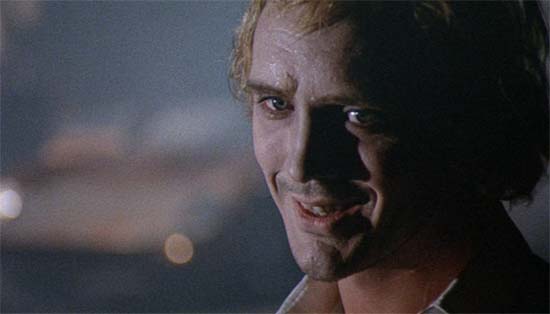 What happens next is both gorgeously shot and indelibly haunting. It’s an achievement, to be sure, but Fellini was on a roll, firing on all cylinders. “Toby Dammit” is sandwiched between Juliet of the Spirits (1965) and Fellini Satyricon (1969), and it plays like a transitional work between those films. In its compression, with a witty script elegantly served by a shot-for-shot compositional inspiration, it’s also one of his most wholly successful works. No wonder, then, that “Toby Dammit” is frequently mentioned to the exclusion of Spirits of the Dead, as though it were not part and parcel of the longer film. But there is a unity in these three shorts that’s somewhat rare among the portmanteau experiments; throughout, it’s a film both creepy and beautiful. It would have been an interesting film regardless, but Fellini, at his most inventive and engaged, raises it to the level of a classic.
What happens next is both gorgeously shot and indelibly haunting. It’s an achievement, to be sure, but Fellini was on a roll, firing on all cylinders. “Toby Dammit” is sandwiched between Juliet of the Spirits (1965) and Fellini Satyricon (1969), and it plays like a transitional work between those films. In its compression, with a witty script elegantly served by a shot-for-shot compositional inspiration, it’s also one of his most wholly successful works. No wonder, then, that “Toby Dammit” is frequently mentioned to the exclusion of Spirits of the Dead, as though it were not part and parcel of the longer film. But there is a unity in these three shorts that’s somewhat rare among the portmanteau experiments; throughout, it’s a film both creepy and beautiful. It would have been an interesting film regardless, but Fellini, at his most inventive and engaged, raises it to the level of a classic.









